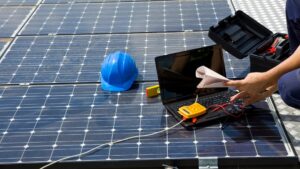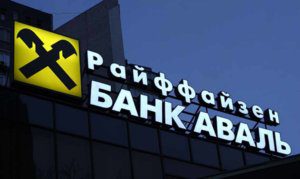
Raiffeisen Bank has opened its fourth underground service area in a shelter in Sumy.
“This is our contribution to ensuring that financial stability remains accessible even in the most difficult conditions,” Artem Nidzelsky, the bank’s retail banking director, was quoted as saying in a press release on Friday.
The underground branch is located in the seventh branch in Sumy at 1 Pokrovska Street.
This is the second such branch in Sumy. Earlier, similar branches of Raiffeisen Bank were opened in Kharkiv and Dnipro. Residents of Sumy can receive a full range of banking services.
According to the National Bank of Ukraine, at the beginning of the year, Raiffeisen Bank ranked 4th (UAH 238.9 billion) among 61 banks in the country in terms of total assets. The financial institution’s net profit as of that date amounted to UAH 222.3 billion.

Raiffeisen Bank (Kyiv) has installed the first solar power plant in a branch located in Obolon district of the capital as part of the implementation of autonomous power sources, the financial institution said on Thursday.
“The 15 kW power plant will ensure uninterrupted provision of financial services even during prolonged power outages. The transition to solar generation also helps to significantly reduce the cost of fuel, generator maintenance and capital repairs,” it said.
It is noted that solar power plants will be used as the main source of electricity and, according to experts, will pay off in 7 years.
Recently, the Ministry of Finance announced the installation of 118 solar roof panels with an area of 310 square meters with a total capacity of 60 kW at its capital office.
“Also, 2 heating stations were modernized, more than 2 km of pipelines were insulated, 558 public lighting fixtures and 42 outdoor lighting fixtures were replaced with more economical ones, more than 200 windows were modernized to reduce heat infiltration and a building energy monitoring system was introduced,” the Ministry of Finance said.
These changes are expected to reduce electricity consumption by 20% and save more than UAH 1.3 million per year.
The Ministry of Finance clarified that these measures were implemented with the support of the German Society for International Cooperation (GIZ) under the project “Promotion of Energy Efficiency and Implementation of the EU Energy Efficiency Directive in Ukraine”.
Minister of Finance Sergii Marchenko added that the work on the energy efficiency of the administrative building is only the first of a number of activities in the framework of cooperation with partners. In particular, the Ministry of Finance plans to modernize the air conditioning and supply and exhaust ventilation systems, as well as to install an energy-efficient glass roof over the building’s atrium.
“After the implementation of all project steps, the building of the Ministry of Finance will become the first government building in Ukraine with a Class A energy efficiency certificate,” the Ministry emphasized in its release.

Raiffeisen Bank International, an Austrian banking group that includes Raiffeisen Bank Aval (Kyiv), has moved the development of its digital banking to Ukraine, according to the Austrian publication Der Standart.
“Software developers (IT was divided into about 30 small flexible divisions) worked on the corresponding applications called Digital Banking Engine for some time. The team in Vienna consisted of 45 people, 33 of whom are internal employees. However, at the end of May the project was moved to Ukraine. IT staff was informed about this on May 25,” the publication said.
The Ukrainian IT company Edenlab will be engaged in further development.
Raiffeisen Bank International is an international banking group headquartered in Vienna. It has almost 47,000 employees, 16.7 million customers and about 2,000 branches, most of which are located in central and eastern Europe.
Ukraine will be able to sign a new program with the International Monetary Fund (IMF) in the amount of $6-8 billion by the end of 2019 and make necessary payments on foreign debt in 2020 and 2021, Raiffeisen analysts predict. In the document, they noted a high probability of obtaining the majority by the pro-presidential party Servant of the People, which was leading in polls with an indicator of 41.5-52.30%, which will ensure the implementation of reforms promised by President of Ukraine Volodymyr Zelensky, due to which Ukraine will be able to receive IMF support.
According to the analysts, even if it fails to independently form the government, the Servant of the People party can form a coalition with Svyatoslav Vakarchuk’s Holos party, which is supported by 5-7% of the respondents.
“Given the commitment of President Zelensky to reforms, the new government will be able to sign a new three-year program with the fund in the amount of $6-8 billion by the end of 2019,” the report says.
Raiffeisen analysts point out that 40% of payments on Ukraine’s gross external debt are in 2020–2021 ($16.8 billion in 2020 and $18.5 billion in 2021), therefore the government needs a new cooperation program with the IMF as soon as possible. “Even given the full rollover of inter-company loans and the refinancing of 50% of corporate credits, Ukraine will have to pay $12.5 billion in 2020 and $15 billion in 2021,” the document says.

Raiffeisen Bank Aval (Kyiv), which earlier was a potential bank for sale, seeks to step up development in the coming years, First Deputy Board Chairman Gerhard Bösch has said. “In the past two years we showed a marked increase in Ukraine and we have ambitious plans regarding business growth in the next three years,” he said at a press conference. Bösch did not give the details of the plans. He expressed doubt that the previous plans of Raiffeisen Bank International AG (RBI, Austria) to sell the Ukrainian subsidiary are remain in force.
“I do not know if these negotiations are held. They were held in 2013 and were stopped along with the events in Maidan. In 2017, Raiffeisen Bank Aval showed itself as the most profit-making bank in the RBI group. We consider ourselves the best asset in the group, and as a rule, these assets are not sold,” he said.
Raiffeisen Bank Aval was founded in 1992. As of June 30, 2017, Raiffeisen Bank International (RBI, Austria) owned 68.28% of the Ukrainian bank’s charter capital, while the European Bank for Reconstruction and Development (EBRD) held 30%.
Raiffeisen Bank Aval ranked fifth in terms of assets worth UAH 72.108 billion among 84 operating banks as of January 1, 2018, according to the National Bank of Ukraine.

Public joint-stock company Raiffeisen Bank Aval (Kyiv) saw a 17% rise in net profit in 2017, reaching UAH 4.469 million.
According to an announcement on holding a general meeting of shareholders on April 27, 2018, a copy of which has been forwarded to Interfax-Ukraine, the bank’s assets last year grew by 18.4%, to UAH 66.297 billion, including UAH 36.845 million of loans issued to clients, taking into account reserves (31.6% up year-over-year), UAH 5.727 billion in investment securities (2.7% up), UAH 10.297 billion of cash and its equivalents (0.04% up) and UAH 13.428 billion of other assets (14% down).
The draft decision of the meeting envisages sending UAH 4.244 billion of net profit for 2017 to pay dividends to holders of ordinary shares.
The shareholders also plan to change the type of the company from public one to private JSC, approve the supervisory board with the following members: Martin Gruell (head of the supervisory board), Andriy Stepanenko (deputy head), Joseph Eberle, Harald Kröger, Robert Fritz, Andreea Moraru, Anna Derevyanko, Pavlo Sheremeta and Daniel Bilak (the three last one are independent members).
Raiffeisen Bank Aval was founded in 1992. As of June 30, 2017, Raiffeisen Bank International (RBI, Austria) owned 68.28% of the Ukrainian bank’s charter capital, while the European Bank for Reconstruction and Development (EBRD) held 30%.
Raiffeisen Bank Aval ranked fifth in terms of assets worth UAH 72.108 billion among 84 operating banks as of January 1, 2018, according to the National Bank of Ukraine.